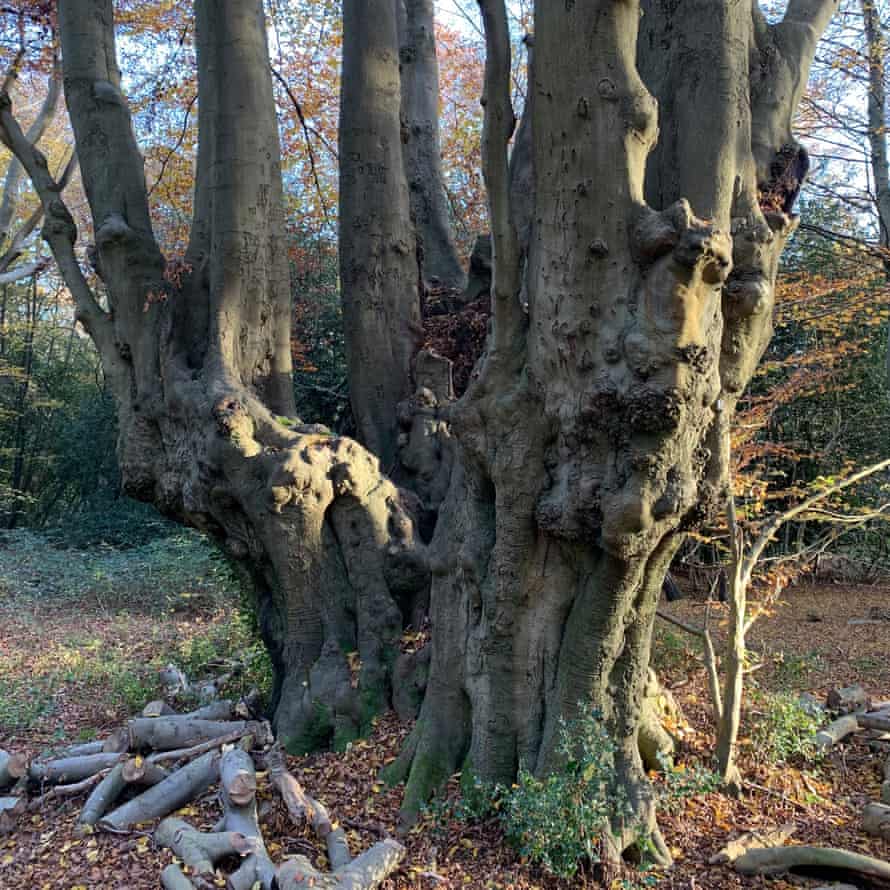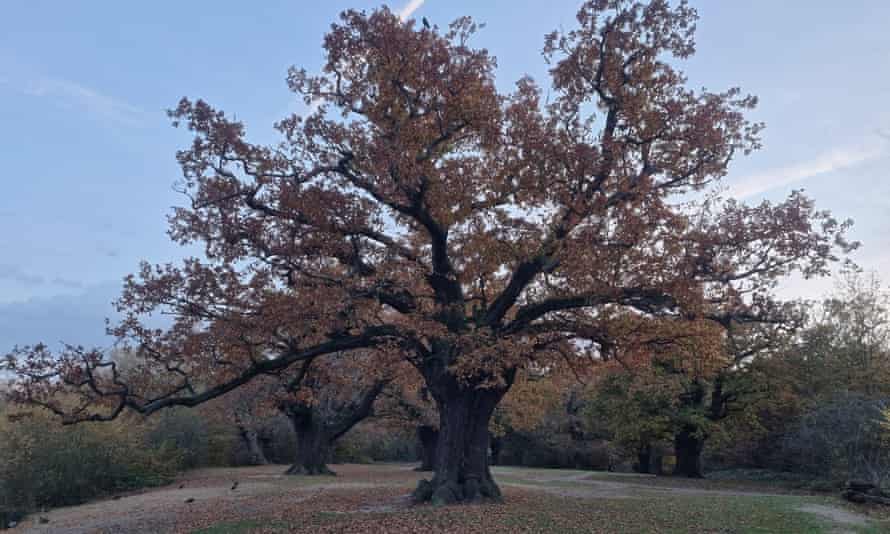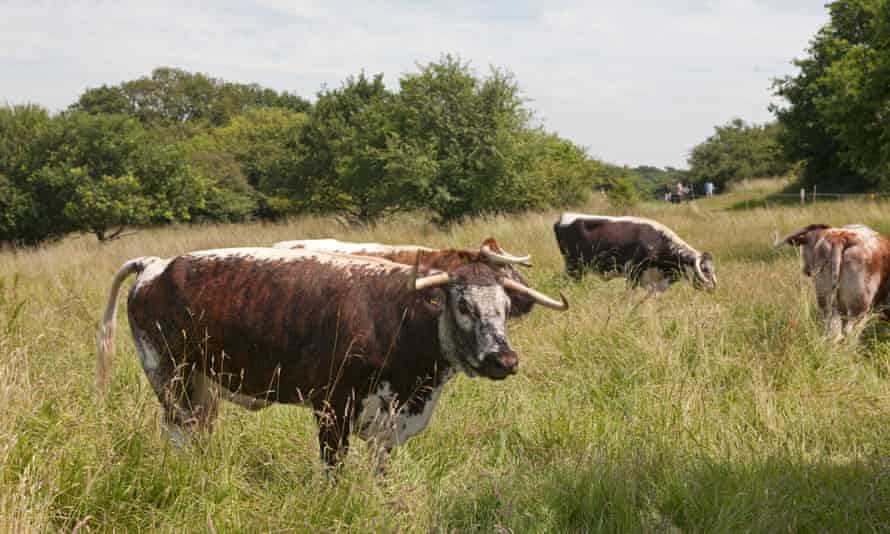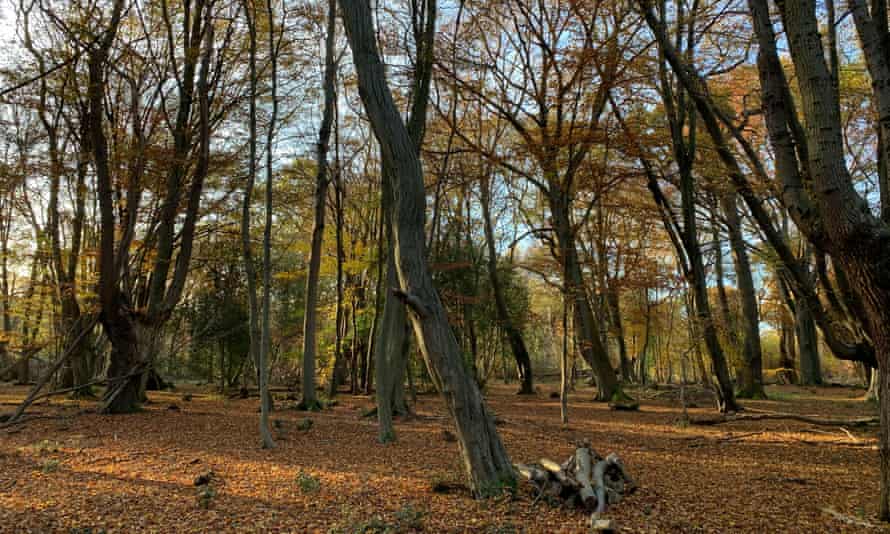I’m no slouch, but I’m struggling to keep up with Jeremy Dagley as he opens a gate off the A104, the main road through Epping Forest, and bounds into the woods. He is the head of conservation here and charmingly eager to show me his work. I had assumed his job would be all wellies and fleeces, clippings and handfuls of soil. The reality is he spends a lot of time indoors helping local councils with planning applications, making sure they are sustainable and sympathetic. It’s clear he’s happier out here.
Jeremy’s knowledge is immense, unspooling in tangles of “ologies”. While telling me that the chalk ridge we are walking along is a ripple caused by the formation of the Himalayas, his ears twitch towards a chirrup and he points to a podgy bundle of grey and black feathers with a bright red cap. It’s a juvenile great spotted woodpecker, says Jeremy. As he regales me with the history of the ownership of this land, I stumble into a hidden ditch; eyes drawn down, he points at a delicate yellow plant. Lousewort, he says, excitedly: it was thought extinct in these parts in the 1990s. It’s thrilling being in the company of such a master.
We’re soon deep in the forest, but it’s still airy and spacious, with the low afternoon sun sending gold from the west. The trees here stand in friendly gatherings, not crowds.

Jeremy stops abruptly by an ugly, gnarled thing, and traces his hands across its snakeskin bark. Beeches normally last 300 years before they conk out and topple over. This one is 800 years old, he says, blue eyes shining. It has tickled the horses of medieval kings, survived centuries of storms, seen off war and pestilence, and remained rooted here in this soil. I feel bad for judging its wrinkles.
In fact its ugliness explains its longevity. Around head height, the snub trunk bulges in a bole, from which a handful of smaller, strong, smooth trunks reach up and branch out in subtle angles. This is the product of pollarding, trimming the tops of trees for wood, a commoner practice here for centuries. Done sparingly, it exposes dormant buds, encouraging new growth. The result is, in effect, a clutch of 200-year-old trees growing from one 800-year-old trunk. Pollarding struck me as a beautiful thing, humankind and nature gaining strength from each other. Conservation by careful use, not the lack of it.
Epping Forest is home to 55,000 ancient pollards: 10,000 oak, 20,000 beech, 25,000 hornbeam. These are pollard riches unmatched in the UK, and they are only half an hour on the overground train from the City of London. During the Covid lockdowns, many Londoners realised their luck: visitor numbers increased by 300%.

As local historian Mark Gorman explains in his book Saving the People’s Forest, such easy access has not always been a given. In the mid-19th century, a new train service to Forest Gate, close to Wanstead Flats, the southernmost point of Epping Forest, brought thousands of new visitors from the East End. About the same time, the crown estate began selling the land to local aristocrats, who sniffed an opportunity to develop housing for the expanding London population. Just as the people had begun to enjoy the public land, it was being taken away.
When, in 1871, Lord Cowley of Wanstead instructed agents to fence off a large section of Wanstead Flats, packed meetings agreed on a march to save the forest. On 8 July, 30,000 people assembled on the Flats, many with gorse in their lapels – a symbol of common land – and tore the fences down. Within a month, parliament passed the first of a series of acts to protect the forest. The City of London Corporation lent support, sensing a popular cause. Between 1871 and 1882, it paid £256,275 to secure conservatorship. With its help, the last of the Epping Forest Acts was passed in 1878, the first legal declaration of the right of the public at large to use an open space for leisure.
It wasn’t all progress. Locals had for centuries had the right in some places to “lop” branches seven feet from the ground for use as fuel over the winter, but this was removed (in return for some compensation) in 1878.

Jeremy is clear this was a mistake. The best thing for biodiversity, he says, is a mosaic environment, a mixture of thorny scrub, grassy clearings and thickets of trees. It makes sense to me. Not everything can live in the darkness and stillness of a thick forest: more niches makes for more species. Pollarding provides helpful disruption, thinning the trees, allowing light for low-growers and providing dead wood for fungi, all encouraging a wider range of fauna.
In 1989, the corporation of London began regular pollarding again, but even before that a visitor here wouldn’t have seen overgrown forest. That’s because grazing rights for commoners were never removed, and cattle continued browsing parts of the woodland through most of the 20th century. As we walked through a lush clearing, Jeremy explained the importance of hungry, clumsy herbivores: they play a similar role to pollarding, causing disruption by nibbling leaves and knocking over young saplings. It’s why the trees here are in friendly gatherings, not crowds.

In the 1990s the delicate balance was upset when the BSE crisis put an end to commoner grazing. In response, the corporation introduced its own herd of longhorns. Most are brought inside for winter, but a handful are left out to help maintain the habitat. Just before sunset, Jeremy took me to Chingford Plain to see them, a hit squad of squat muscle and sharp horns within charging distance of the high street. As they began to edge in that direction, Jeremy showed me his phone, displaying a map of the area with a moving dot for each cow. As one beast neared the virtual boundary, its GPS necklace emitted a high-frequency sound, prompting the animal to lumber off in a different direction. As the light drained from the blue sky, everything here seemed in harmony: humankind, nature, technology. This is what the world can be.
A few weeks earlier I had been at Cop26 in Glasgow, and its gloomy graphs still haunted my dreams: one night I screamed myself awake. I came here needing a lift. If we are to heal the world, it is of course essential to understand how it is degrading. But as US writer Rebecca Solnit says, concentrating on what is being lost can leave us with the sense that decay is normal, inevitable. We need to hold the good bits in mind – finding wonder in what works well. We need to “take that beauty as a sacred trust, and celebrate the memory of it”, she wrote. “Otherwise we might forget why we are fighting.”
There are few finer reminders than Epping Forest.
Daily trains run four times an hour from London Liverpool Street and Walthamstow Central stations to Chingford (five minutes’ walk from Epping Forest)




